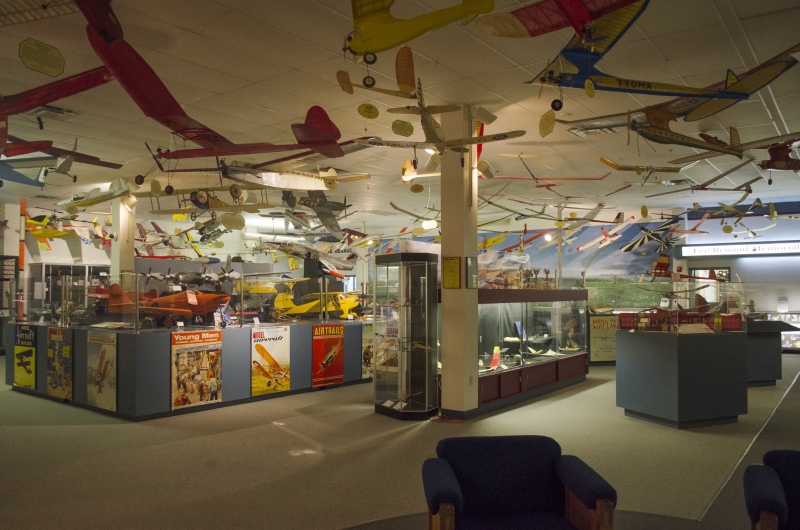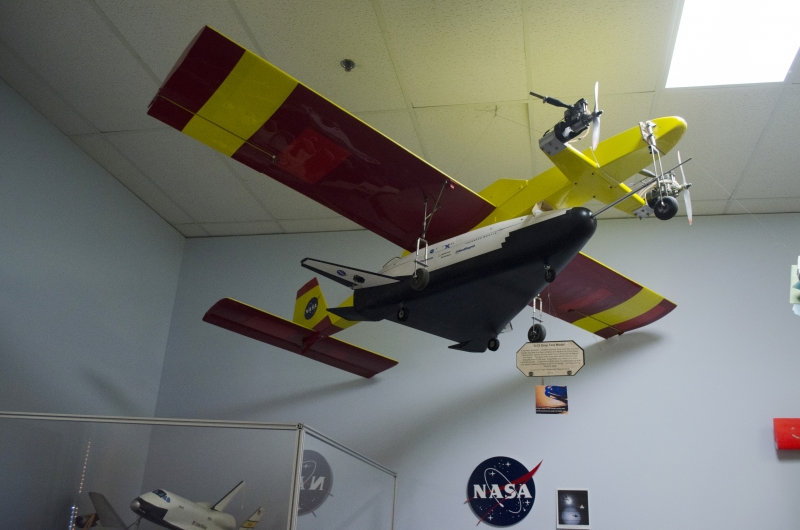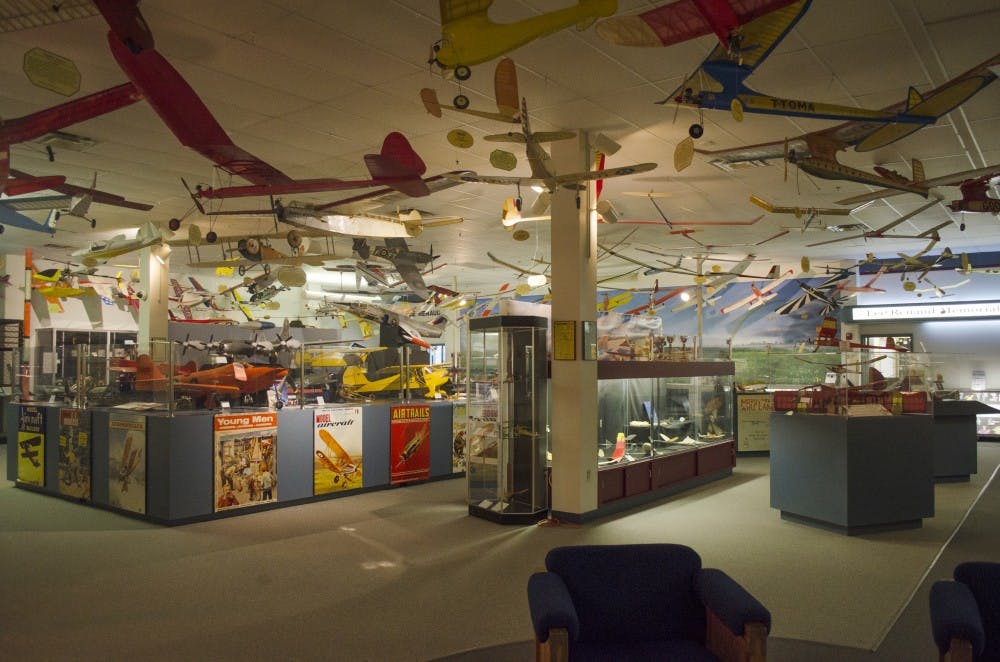
|
| The National Model Aviation Museum houses unmanned aircrafts for recreational use and professional use. Manufacturers and individuals have donated the predecessors to the popularized unmanned aerial vehicles used by the military. DN FILE PHOTO BREANNA DAUGHERTY |
Editor's note: This is the first in a three-part series of space-related articles in celebration of the 45th anniversary of the moon landing. To see the second article, click here. To read the third article, click here.
The United States turning 238 isn’t the only American milestone in July.
Nearly 45 years ago, a Saturn-V Rocket launched from the John F. Kennedy Space Center, carrying the crew of the first men to walk the lunar surface. And 45 years later, that excursion has rippled across the nation and the world to the smallest of Midwest towns, like Muncie.
On the outskirts of town, surrounded by open fields, sits the Academy of Model Aeronautics and the National Model Aviation Museum, curated by Michael Smith.
National Model Aviation Museum5151 E. Memorial Drive in Muncie Summer hours until Sept. 7 9 a.m.-4:30 p.m. Mondays through Fridays 10 a.m.-4 p.m. Saturdays and Sundays Admission AMA members: Free Adults: $4 Children, ages 6-17: $2 Younger than 6: Free |
Inside, about 100 different model aircraft hang with a mural in the background. The painting shows two kids playing with a model airplane in a field. A pair of astronauts are seen leaving the space shuttle on their left and renowned pilots Charles Lindbergh and Amelia Earhart are depicted on their right.
“Our mural here envisions the thrill of flight,” Smith said. “Kids out on a nice day flying a rubber-powered free flight model. It’s that inspirational moment, and you never know when it might spark and what it might lead to.”
In a wing of the museum, various radio-controlled target drones used by the military are displayed. Alongside them are the first unmanned aircraft to carry explosives or cameras for reconnaissance missions, such as the Pioneer used in the Gulf War, the first major unmanned aircraft that provided live feed on the battlefield and paved the way for the wide variety of craft the military uses today, such as the RQ-4 Global Hawk and MQ-1 Predator.
In the same room are unmanned vehicles created for a less destructive purpose.
“The space shuttle that’s over there with the 747 on top was actually designed by two NASA engineers who were modelers, as well,” Smith said. “[They] experimented with ideas and concepts in model size in order to look at the full-scale development of the space shuttle. [There is] a lot of bleed over in terms of the people and skills and what they are doing.”
Often times, the men and women engineering the next generation of flight and space flight are model hobbyists themselves or use models to emulate how the actual craft will perform, Smith said in a tour of the museum he gave the Daily News.
“You had a lot of the same people who were both doing this as a hobby as well doing it in their job,” he said. “And a lot of the main companies like McDonnell Douglas, they had a model airplane club at the factory. There were many airplane manufacturers that had model enthusiasts and clubs.”
The museum’s space test craft are on loan from the NASA Armstrong Flight Research Center, formerly known as NASA’s Dryden Flight Research Center. This includes craft such as a model of the X-33, a proposed replacement for the space shuttle.

|
| The X-33 drop test model holds on to the “mothership” in the National Model Aviation Museum. These are on loan to the Muncie museum from NASA and were used at the Edwards Air Force Base before being retired. DN FILE PHOTO BREANNA DAUGHERTY |
“They came to us because ... the person who was working there at the model shop was a longtime air model enthusiast, and he recognized the value of these models for others,” Smith said. “So he was able to work out an agreement where we ... are able to display them.”
Manufacturers and individuals have donated the predecessors to the popularized unmanned aerial vehicles, commonly known as drones, used by the military.
It’s not just the weekend hobbyists who play with model aircraft, Smith said.
“NASA is still very interested in unmanned vehicles as research tools,” he said. “Even today with everything being designed on computers, they still use subscale models and drop them in order to get real world test numbers.”
|
Other NASA inspired tech
SOURCES: spinoff.nasa.gov, nasa.gov, discovery.com |
However, the future of this technology doesn’t just exist in its use for testing or military purpose. Their use and development bleeds through to everyday life, just how the technology used in the Apollo missions bled through into society almost a half a century ago, Smith said.
“For unmanned air systems in general, there is tremendous growth potential,” he said. “Being able to alleviate the pilot on board removes the risk. There is going to be a potentially huge evolutionary change, even on land and sea. What does the future look like when you don’t have to drive the car?”
Other potential uses for unmanned systems in society are commercial delivery or monitoring forest fires.
The bleed through Smith discussed refers to how the miniaturization of components led to mass-produced radio equipment for model aircraft available at stores.
However, on a larger scale, NASA research and endeavors has led to LED lights, ear thermometers, safety grooving on highways and water filters, to name a few.
Smith said NASA and space exploration as a whole have given more to society than some people realize.
“There are a lot of discoveries and advancements made today that a lot of people just go, ‘Oh gee-whiz, that’s cool’ and don’t realize the implications of them and won’t until we see applications for them in our everyday lives,” he said.


![A member of Open Door Health Services [ODHS] Connections Team meets with a resident and assists them with enrolling in a health insurance plan in 2024. CEO and President of ODHS Bryan Ayars said around 10%-11% of their patients they see are uninsured. ODHS, Photo provided](https://snworksceo.imgix.net/bsd/6f04939c-59ef-4f5b-930d-1ab3f45749c1.sized-1000x1000.jpg?w=1000&ar=4%3A3&fit=crop&crop=faces&facepad=3&auto=format)


